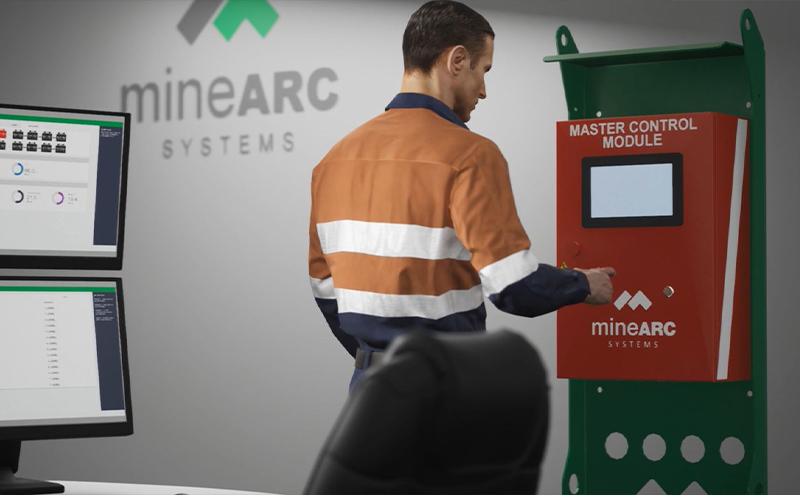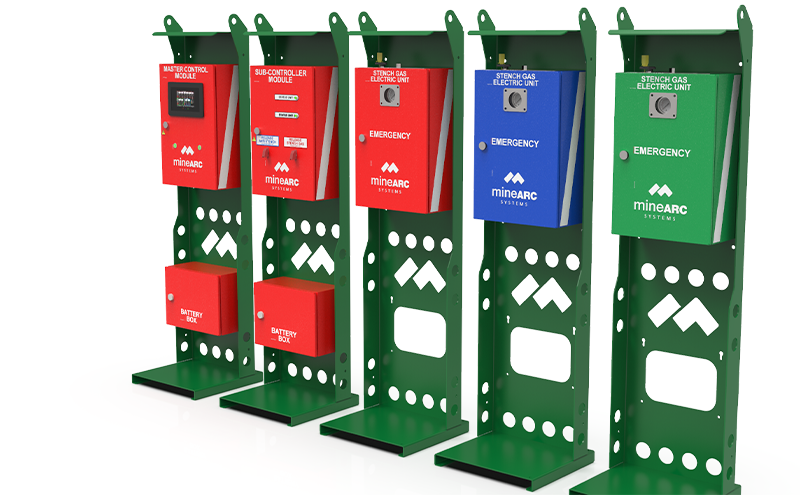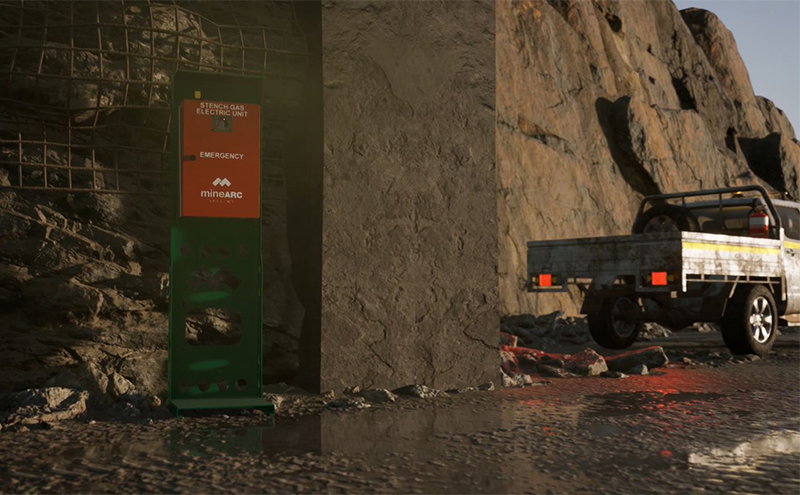Stench Gas is an underground alert system designed to suit noisy environments where audible alarms may not be heard. During an emergency, the distinct and recognisable odour is rapidly dispersed through the ventilation system, prompting personnel to head to a safe area.
What is Stench Gas and is it flammable?
Underground mines and tunnel construction rely on a series of sensory alarm systems to warn staff in an emergency, including visual, audible and olfactory.
Stench gas systems contain Ethyl Mercaptan, pressurised with gases to be dispersed as an emergency warning. In addition, some stench gas systems are classed as flammable.
What is Ethyl Mercaptan
The critical element within stench gas is Ethyl Mercaptan, also known as Ethanethiol. It is clear and colourless with an overpoweringly pungent smell similar to garlic and decaying cabbage.
Ethyl Mercaptan is classified as flammable and can be toxic if swallowed or inhaled in large quantities.
Ethyl Mercaptan (Ethanethiol, Thioethyl alcohol)
- Formula: C2H5SH
- Molecular Weight: 62.13 g/mol
- Specific Gravity: 0.839 (H20=1)
- Vapor density: 2.14 (Air = 1)
Table 2.0 Ethyl Mercaptan
| Concentrations | Concentration |
| Odor threshold | 0.6ppb or 0.0006ppm |
| Ideal concentrating at release | 0.1-2 ppm1 |
| TWA (8 hour) | 0.5ppm |
1Based on ventilation rates of 50,000-2,000,000cfm (20-1,000m3/s) ppm = (grams / m3) x (24.46/62.13)
How Ethyl Mercaptan Forms Stench Gas
When added to an odourless gas, pressurised Ethyl Mercaptan is propelled through large volumes of mine air. Due to its scent, it is easily detected and recognised even in small quantities. As the vapours are heavier than air, the gas solution descends creating a lingering effect.
Non-Flammable Stench Gas
MineARC Stench Gas cylinders are loaded with Ethyl Mercaptan, pressurised with a non-flammable gas. It is pressurised further with nitrogen.
A standard one-litre cylinder of MineARC Stench Gas contains 100g of Ethyl Mercaptan. It can be distributed efficiently through approximately 620,000 cubic metres of air in an underground mine, operating within a temperature range of 1°C to 54°C.
Table 1.0 MineARC Stench Gas Ratio
| Composition | Percentage |
| Tetrafluorethane (R-134A) | 80% |
| Ethyl Mercaptan | 15% |
| Nitrogen | <5% |

How Can Stench Gas Be Non-Flammable?
Pure Ethyl Mercaptan is a flammable product. In the air, the
- Lower Flammability Limit (LFL) of Ethyl Mercaptan is 2.8% by volume
- Upper flammability limit (UFL) of Ethyl Mercaptan is 18.2% by volume
Altering the flammable properties of Ethyl Mercaptan within the stench gas cylinders is due to the incorporation of the non-flammable material – Tetrafluorethane. Combining Tetrafluorethane within the cylinders prevents flammable levels from being formed; hence the end product at the point of dispersion is not flammable.
Testing on MineARC Stench Gas uses the ASTM method E-681. The internationally recognised standard verification method for testing concentration limits of chemicals’ flammability in the air.*
In testing, concentrations of the solution mixed with varying oxygen levels. These level changes determine if there is a percentage by volume that will create an explosive mixture.
Independent bodies conducted the testing using the ASTM method E-681. Concentrations of the solutions to air and oxygen levels in the air were modified in various scenarios. They found no flammable concentration.**
Safety Precautions of Ethyl Mercaptan
Although classed as non-flammable, MineARC’s Stench Gas contains Ethyl Mercaptan, a hazardous chemical stored under pressure. As such, all safety precautions apply to the handling and transportation of stench gas cylinders.
It is important to note that as solutions can separate over time, to ensure the stench gas is safe and effective, there is a two-year shelf life on the gas cylinders from date of manufacture.
Government Regulations for Stench Gas Alert Systems
MineARC Systems Stench Gas complies with the Australian Government Regulation 4.37 in the guidelines set down in ‘Emergency Preparedness for Underground Fires in Metalliferous Mines’ developed and approved by the Department of Mines, Industry Regulation and Safety, as well as the Mines Occupational Safety and Health Advisory Board (Australia).
Flammable materials or explosives not to be stored near mine openings Regulation 4.37 The manager of an underground mine must ensure that flammable liquids, flammable materials or explosives are not stored within 50 metres of any entrance to the mine. Penalty: See regulation 17.1.
Stench Gas Systems in Hard Rock Mining
Stench gas is a practical and far-reaching alert system; due to the enclosed nature of mines, internal ventilation, and ability to work independently from underground communication systems such as radios or lighting.
MineARC Stench Gas Units contain three main components, in a manual and electric format:
- Stench Gas: A malodorous gas used to identify risk and provide an olfactory warning to personnel where visual and audible alerts may not be adequate.
- Anti-Stench: Works as a cleaning agent to clean the compressed air lines after activation.

- Wintergreen: A more pleasant smelling gas commonly used as an “all-clear” signal, indicating that the mine and personnel can leave the safe area and return to work or the surface. It has also been used as an emergency alert on worksites where foul odours are common.
Underground Mine Ventilation and Stench Gas
Incorporating a complete stench gas system requires custom calculations to determine the units’ best placement for proper dispersion.
Areas such as ventilation junctions or inlet fans are ideal for dispersing stench gas urgently. Ventilation managers are an essential part of stench gas discussions and placement due to each mine’s unique nature, its ventilation system, and their in-depth knowledge.
Two main criteria need to be met by the system, volume and velocity of ventilation air.
- Volume: The quantity of stench gas required to remain detectable, must at least match the volume of air in the mine, for example, two cylinders will be detectable across approximately 1.25 million cubic metres of air.
- Velocity: The momentum of air required to ensure adequate deployment times. An example scenario; a 3000m mine with personnel at bottom and stench gas located at the portal.
Option A
Assume mine air in the decline is moving at a rate of 0.5 m/sec
3000 m / 0.5 m/sec = 6000 sec
A total of 100 minutes to reach personnel at the bottom of a mine is an unacceptable rate.
Option B
Inject directly into ventilation system at a rate of 20 m/sec
3000 m / 20 m/sec = 150 sec
A total of 2.5 minutes to reach personnel at the bottom of a mine is the better option as response time is much quicker.
Further to this, the size and complexity of a mine will influence the number of stench gas units required.
Stench gas is a universal alert system used in underground mining and tunnel construction, where specific variables can increase the need for a broad range of alert systems.
The chemical composition of MineARC Stench Gas is classified as non-flammable. Therefore, it is suitable to be stored and used throughout the mine as part of an integrated emergency response plan.
References
*ASTM E681-09(2015), Standard Test Method for Concentration Limits of Flammability of Chemicals (Vapours and Gases), ASTM International, West Conshohocken, PA, 2015
**Southwest Research Institute (research laboratory for design and development of the product application) and Chilworth Technology, Inc. (a global leader in explosion and process safety)






